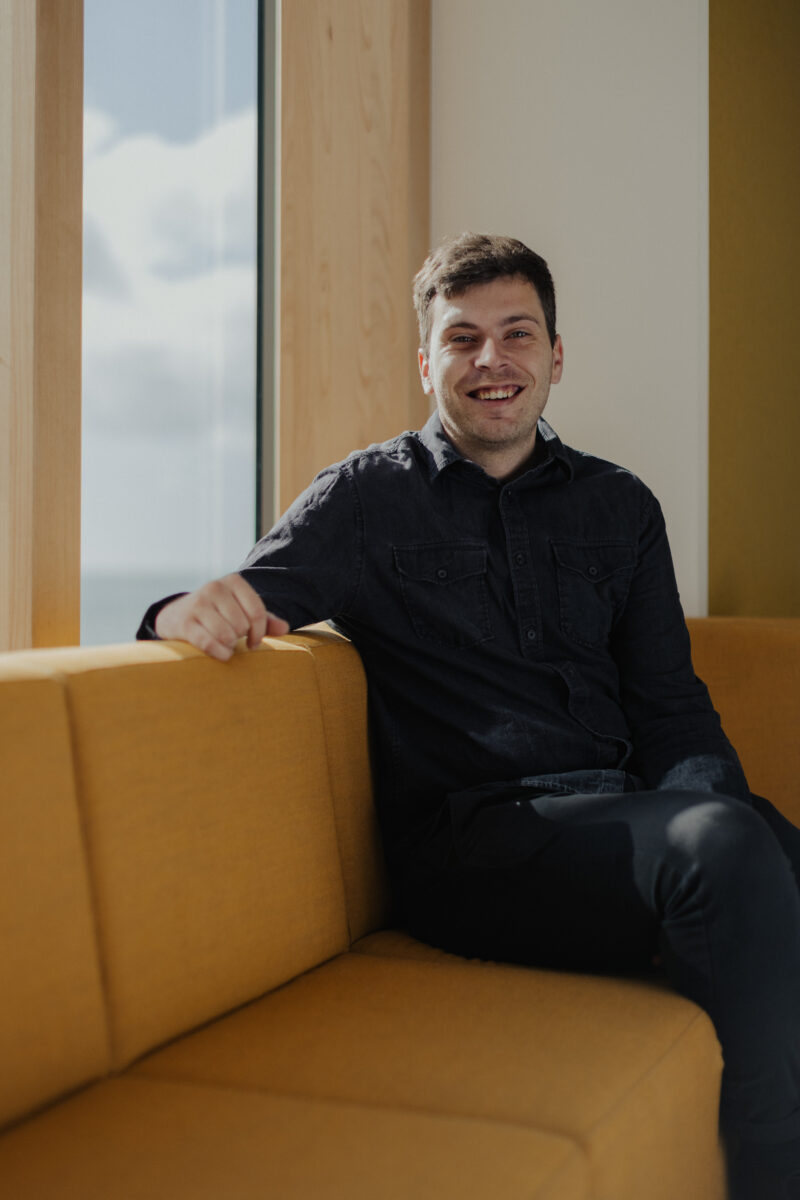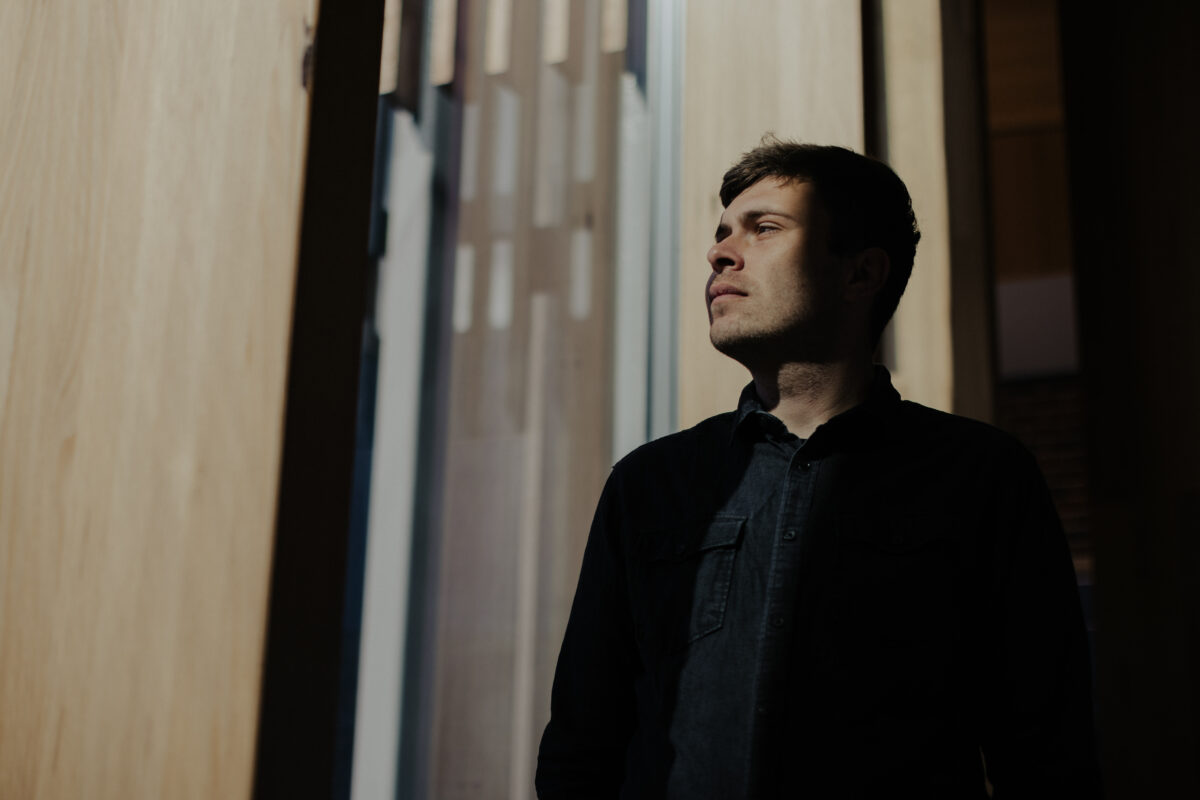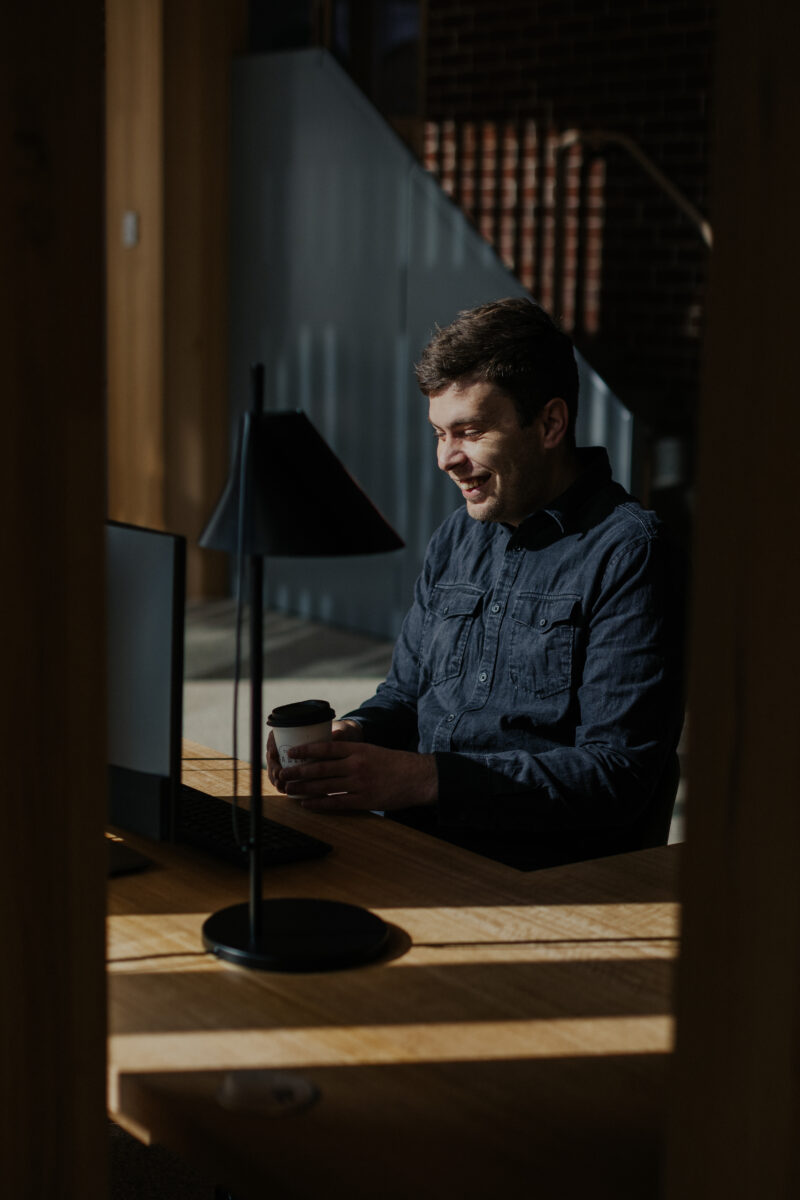

Caleb Nichols-Mansell is a proud Palawa/Tasmanian Aboriginal man, and a freelance artist specialising in graphic design and digital art across multiple platforms. Caleb founded and owns Blackspace Creative – the only Aboriginal owned and operated arts and cultural hub in Tasmania, selling artwork from 21 Tasmanian Aboriginal artists. Caleb delivers cultural engagement and creates cultural frameworks for festivals including Dark MoFo, Junction Arts Festival, Ten Days on the Island and PANAMA.
In this dialogue with Tiwi Producer, Libby Collins, Caleb discusses artist empowerment, organisations needing to act with deep purpose, listening and thinking, the importance of embedding context specific cultural interfaces, and honouring culture, community and Country as First Nations artists.
What would you consider best practice in your field when developing engaging and approaching First Nations content?
It depends on the role I’m working in. As a freelance artist, best practice is empowering and valuing Aboriginal artists. Often in my work I encounter ad hoc decisions or decisions that have been made at the very last minute to include or incorporate Aboriginal artwork, content or things. When I’m told the budget or timeline that an organisation is working with, it can become really clear that my involvement in the project has been a last minute decision. They’ve pulled from a cash pool that’s not very big, only allocating between a couple hundred to a thousand dollars for stuff that’s quite in-depth or takes a lot from you as an artist to create and perform. I’m quite often approached by organisations to do the artwork for their Reconciliation Action Plan (RAP), or other corporate documents. For such projects that are supposed to be about positioning and platforming First Nations people within their organisation and reconciling relationships that have been broken down over the years, there is very little planning and thought put into how they’re going to engage Aboriginal artists and actually maximise their organisation’s engagement with our community.
So it involves committing to some deep thinking around why you’re actually engaging an Aboriginal person, and what the benefits are to that person and their community.
Full disclaimer: I’ve only ever done two RAPs, but I’ve been approached to do well over 10. And more often than not, I turn them down. The first thing I ask for is the RAP itself, to gauge whether the organisation has actually thought about what they’re asking for or what they’re proposing and how that feeds back into my community. How is my community benefiting? How are they going to benefit from the goals and actions that an organisation has set out? Does it go beyond the template provided by Reconciliation Australia? I also like to analyse how likely an organisation is to achieve the actions and goals within their RAP, because I think more often than not organisations can overcommit, going above and beyond to make their document look great while the internal structures aren’t actually there to achieve what they’re saying they’re going to.
Best practice is about empowering our artists; that’s the underlying model we’ve got at Blakspace. Our aim is to make ourselves redundant. I want to build up our community artists and their capacity so that Blakspace doesn’t actually need to exist anymore. Best practice is ensuring that we provide the tools and support that’s necessary for our Mob to be able to go out there and create their own brand, build their confidence and build a broader awareness around what they do and who they are as community artists.
With festivals, it’s important to measure the commercialisation of what a festival is commissioning. How is that piece of art being used? Is that commission going to go on sale through another company? A lot of companies will approach you and ask for Black artwork so that they can position themselves as Black-supporting or Black allies. But they also use that artwork in a way that builds their capital.
As much as we want to dance around it, Blackness in today’s economy is money, particularly for white organisations. The more Black they can be or appear, the more likely they are to receive funding from these different pools that exist across the country. When I’m doing a commission, it’s important to have the strength to challenge a company’s authority. But there are complexities to this. I’m lucky enough to have the privilege to be able to turn offers down. And that really comes down to that ethical checklist I go through.
Another thing we might not think about as practising artists, especially when making decisions in the spur of the moment, is how providing artwork for an organisation can sometimes translate as an endorsement, as you personally providing credibility for that organisation. But to turn them down, to measure a company’s integrity, is quite tricky for Mob to navigate. You need the confidence and stability to be able to sit with those kinds of decisions, and make the decision that’s best for both your practice as an artist, but also your community which is who you ultimately represent through your work.
Best practice for organisations is also about embedding the cultural interface of Palawa/First Nations people within their structures, so that there is an understanding and a recognition of the differences between what my Western or white colleagues have to deal with on a day-to-day basis and what my Black colleagues experience. This extends to conversations around workload.
For example, as a Black father, my responsibilities go outside of the workplace and extend to my family, friends and community. I’m not saying that white people don’t have the same responsibilities, but our way of working doesn’t necessarily fit with this [Western] nine to five. Often I’ll knock off at 5 and think that I’m done, and then I’ve got Mob calling up at 10 o’clock at night wanting to yarn. Really trying to embed a recognition of this within an organisation is crucial, to acknowledge where they need to provide more flexibility or understanding around our cultural differences and how they play out within the workplace. We’ve got the exact same workload and expectations as our colleagues, but with the addition of our cultural obligations as Blackfellas.
I try to exhibit best practice as a freelance artist by honouring my old people in our stories and connection to Country. If I receive a brief from an organisation asking for an artwork that represents connection and kin and community because that’s what their business “stands for”, then I have to go away and have a look at what I can provide for them that authentically meets that brief. But I also need to provide this in a way that doesn’t sell out my community, because our stories and our artwork are deeply embedded in our culture and our history. Our connection to Country is not transactional. As artists, there is a need to protect our cultural intellectual property while also sharing it so that we can open up conversation and space for people to talk. We can make hard conversations more approachable by centering them around an artwork, around something so beautiful, around something that depicts how our cultural practices have been sustained despite the impacts of colonisation and invasion.
Would you mind expanding on how best practice is exhibited as an artist also?
My processes start with how I hold myself as an artist, my own expectations and how I stay true to those. These expectations are about platforming other voices and making sure that the voices I place at the table are as diverse as they can possibly be. And that’s really hard down here in Tasmania – without discounting that it’s hard elsewhere, the effects of invasion and colonisation were harsh, and the impacts of this are still reverberating through behaviours and perceptions within our own Aboriginal community. So we’ve got lots of politics around identity, who is Mob and who isn’t Mob, who has authority to speak and who doesn’t, and how are these politics then talked about in a public setting. I’m very conscious of my age in this context – when Dark Lab appointed me as their cultural advisor, it felt kind of culturally wrong as a younger person, like I didn’t have the status within our community to hold this title. But with the assistance of my community, I’ve come to see myself as a conduit that connects festivals with the community, someone who, because of my connection to community and to culture and Country, is able to identify who the correct people are to be connecting these festivals with, and how to build a culture within these festivals that respects and acknowledges our culture and our cultural identity. I try to bring as many people as possible from our community into the conversation, to talk about what can be improved and what is working.
Being open to feedback as an emerging artist is also really important. At the start of my career, I was constantly getting pulled up by Mob asking: “What is that symbol doing there? Why are you sharing this? Why are you commercialising it? Do you understand the repercussions that stem from that?” Embedding self-reflection into your practice and being accountable to your community is critical.
Have you seen a change in the industry over the years? I feel like you’ve been part of that change…
One hundred percent I think that the industry has changed. I do often think, however, about how what we perceive as progression can actually sometimes be us going backwards. I often wonder within the Aboriginal Arts and Cultural Industry – where culture and art have become so commercialised and readily available – what are the boundaries? Where our intellectual cultural property is being represented by mainstream organisations, at what cost is progress taking place? How do we protect ourselves to ensure that we’re not exploited and that our work is not used out of the context that we initially intended it be used for? As much as there has been progress in the industry, I worry about all of these little gaps that we haven’t really ironed out.
Perhaps we should develop guidelines in regards to our arts and cultural practices and the sharing of these things. But, as a diverse people, certain standards may not be representative of our entire island community, they might just be the voice of one group. There needs to be conversation facilitated between all those with a vested interest in arts and culture; a seat at the table for everyone. Moreover, I feel that for Black performance, Black dance, Black song and Black musicians, there has been massive progress with the development of industry standards. However, for Aboriginal arts and culture, public art, commissioning art, using cultural objects and operating as freelance artists, these types of frameworks don’t currently exist.
What do you like to see for the future?
I want to see more Black-owned and Black-led enterprises. I want to see more Black people doing it for Mob and less of these white people. I have a very nuanced relationship with white people that want to do good. They want to do good so badly that it’s almost condescending, almost limiting to the Black person they are working with. Everyone is saying let’s get Blackfellas into business, but then white people are still keeping the lid on the box, not giving Blackfellas the tools to get out there and actually do business themselves. That’s how Blackspace Creative was born, out of a need that I could see within my community to better equip our artists. We had so many talented community artists, but none of them had the skill set or knowledge of how to run a business, manage finances, tax obligations and admin, or how to market themselves or price their work… And so Blackspace was formed to empower community members to go out and do it for themselves.
I want to see capacity building and empowerment for Mob across the country, in all industries, whether it’s dance, music, art or the commercial world. I want to see white people giving up their positions and giving them to Black people. I want to see white people acknowledging their privilege and passing that privilege on to Black people. That, to me, is change.
And we can talk about progress and change at a very superficial level, like “let’s create an identified position.” But what does that identified position mean? If your workplace isn’t culturally safe, or a Black person doesn’t feel welcome within that workspace, then that identified position is just utilising your RAP plan to make you feel good and to make your business look good. It looks like progress or opportunity, but it doesn’t benefit my community. If we’re talking about the future, let’s actually talk about the progress we wish to see in it, the empowerment of Mob, placing Mob in positions of authority, decision-making and ownership.
I’m at a point in my life and career where I want to hear our narrative from us, have our narrative told by us.
So self-determination fits into this industry?
It’s the only way for the industry to grow. I feel like we’ve reached a kind of peak at the moment, and unless Aboriginal people are given the opportunity to determine where their futures are heading, there is no more room for growth. I feel like we’ve really hit the pinnacle in terms of Blackfellas joining the crowd, walking along with the crowd, but I don’t know how the industry will develop or grow any further without power and recognition being handed over. White people must acknowledge that they hold that power, that autonomy, that authority, and hand it over authentically and with deep, deep purpose, not just for show.

Caleb Nichols-Mansell. Credit to Jaz Upton of Mooncheese Studio.
Project led by:

Supported by:

In partnership with:
![]()
